Shijin Wang
Evaluating LLMs Across Multi-Cognitive Levels: From Medical Knowledge Mastery to Scenario-Based Problem Solving
Jun 10, 2025Abstract:Large language models (LLMs) have demonstrated remarkable performance on various medical benchmarks, but their capabilities across different cognitive levels remain underexplored. Inspired by Bloom's Taxonomy, we propose a multi-cognitive-level evaluation framework for assessing LLMs in the medical domain in this study. The framework integrates existing medical datasets and introduces tasks targeting three cognitive levels: preliminary knowledge grasp, comprehensive knowledge application, and scenario-based problem solving. Using this framework, we systematically evaluate state-of-the-art general and medical LLMs from six prominent families: Llama, Qwen, Gemma, Phi, GPT, and DeepSeek. Our findings reveal a significant performance decline as cognitive complexity increases across evaluated models, with model size playing a more critical role in performance at higher cognitive levels. Our study highlights the need to enhance LLMs' medical capabilities at higher cognitive levels and provides insights for developing LLMs suited to real-world medical applications.
CogMath: Assessing LLMs' Authentic Mathematical Ability from a Human Cognitive Perspective
Jun 04, 2025Abstract:Although large language models (LLMs) show promise in solving complex mathematical tasks, existing evaluation paradigms rely solely on a coarse measure of overall answer accuracy, which are insufficient for assessing their authentic capabilities. In this paper, we propose \textbf{CogMath}, which comprehensively assesses LLMs' mathematical abilities through the lens of human cognition. Specifically, inspired by psychological theories, CogMath formalizes human reasoning process into 3 stages: \emph{problem comprehension}, \emph{problem solving}, and \emph{solution summarization}. Within these stages, we investigate perspectives such as numerical calculation, knowledge, and counterfactuals, and design a total of 9 fine-grained evaluation dimensions. In each dimension, we develop an ``\emph{Inquiry}-\emph{Judge}-\emph{Reference}'' multi-agent system to generate inquiries that assess LLMs' mastery from this dimension. An LLM is considered to truly master a problem only when excelling in all inquiries from the 9 dimensions. By applying CogMath on three benchmarks, we reveal that the mathematical capabilities of 7 mainstream LLMs are overestimated by 30\%-40\%. Moreover, we locate their strengths and weaknesses across specific stages/dimensions, offering in-depth insights to further enhance their reasoning abilities.
MMATH: A Multilingual Benchmark for Mathematical Reasoning
May 25, 2025Abstract:The advent of large reasoning models, such as OpenAI o1 and DeepSeek R1, has significantly advanced complex reasoning tasks. However, their capabilities in multilingual complex reasoning remain underexplored, with existing efforts largely focused on simpler tasks like MGSM. To address this gap, we introduce MMATH, a benchmark for multilingual complex reasoning spanning 374 high-quality math problems across 10 typologically diverse languages. Using MMATH, we observe that even advanced models like DeepSeek R1 exhibit substantial performance disparities across languages and suffer from a critical off-target issue-generating responses in unintended languages. To address this, we explore strategies including prompting and training, demonstrating that reasoning in English and answering in target languages can simultaneously enhance performance and preserve target-language consistency. Our findings offer new insights and practical strategies for advancing the multilingual reasoning capabilities of large language models. Our code and data could be found at https://github.com/RUCAIBox/MMATH.
How Does Sequence Modeling Architecture Influence Base Capabilities of Pre-trained Language Models? Exploring Key Architecture Design Principles to Avoid Base Capabilities Degradation
May 24, 2025Abstract:Pre-trained language models represented by the Transformer have been proven to possess strong base capabilities, and the representative self-attention mechanism in the Transformer has become a classic in sequence modeling architectures. Different from the work of proposing sequence modeling architecture to improve the efficiency of attention mechanism, this work focuses on the impact of sequence modeling architectures on base capabilities. Specifically, our concern is: How exactly do sequence modeling architectures affect the base capabilities of pre-trained language models? In this work, we first point out that the mixed domain pre-training setting commonly adopted in existing architecture design works fails to adequately reveal the differences in base capabilities among various architectures. To address this, we propose a limited domain pre-training setting with out-of-distribution testing, which successfully uncovers significant differences in base capabilities among architectures at an early stage. Next, we analyze the base capabilities of stateful sequence modeling architectures, and find that they exhibit significant degradation in base capabilities compared to the Transformer. Then, through a series of architecture component analysis, we summarize a key architecture design principle: A sequence modeling architecture need possess full-sequence arbitrary selection capability to avoid degradation in base capabilities. Finally, we empirically validate this principle using an extremely simple Top-1 element selection architecture and further generalize it to a more practical Top-1 chunk selection architecture. Experimental results demonstrate our proposed sequence modeling architecture design principle and suggest that our work can serve as a valuable reference for future architecture improvements and novel designs.
am-ELO: A Stable Framework for Arena-based LLM Evaluation
May 06, 2025Abstract:Arena-based evaluation is a fundamental yet significant evaluation paradigm for modern AI models, especially large language models (LLMs). Existing framework based on ELO rating system suffers from the inevitable instability problem due to ranking inconsistency and the lack of attention to the varying abilities of annotators. In this paper, we introduce a novel stable arena framework to address these issues by enhancing the ELO Rating System. Specifically, we replace the iterative update method with a Maximum Likelihood Estimation (MLE) approach, m-ELO, and provide theoretical proof of the consistency and stability of the MLE approach for model ranking. Additionally, we proposed the am-ELO, which modify the Elo Rating's probability function to incorporate annotator abilities, enabling the simultaneous estimation of model scores and annotator reliability. Experiments demonstrate that this method ensures stability, proving that this framework offers a more robust, accurate, and stable evaluation method for LLMs.
MiMu: Mitigating Multiple Shortcut Learning Behavior of Transformers
Apr 14, 2025Abstract:Empirical Risk Minimization (ERM) models often rely on spurious correlations between features and labels during the learning process, leading to shortcut learning behavior that undermines robustness generalization performance. Current research mainly targets identifying or mitigating a single shortcut; however, in real-world scenarios, cues within the data are diverse and unknown. In empirical studies, we reveal that the models rely to varying extents on different shortcuts. Compared to weak shortcuts, models depend more heavily on strong shortcuts, resulting in their poor generalization ability. To address these challenges, we propose MiMu, a novel method integrated with Transformer-based ERMs designed to Mitigate Multiple shortcut learning behavior, which incorporates self-calibration strategy and self-improvement strategy. In the source model, we preliminarily propose the self-calibration strategy to prevent the model from relying on shortcuts and make overconfident predictions. Then, we further design self-improvement strategy in target model to reduce the reliance on multiple shortcuts. The random mask strategy involves randomly masking partial attention positions to diversify the focus of target model other than concentrating on a fixed region. Meanwhile, the adaptive attention alignment module facilitates the alignment of attention weights to the calibrated source model, without the need for post-hoc attention maps or supervision. Finally, extensive experiments conducted on Natural Language Processing (NLP) and Computer Vision (CV) demonstrate the effectiveness of MiMu in improving robustness generalization abilities.
Chain of Strategy Optimization Makes Large Language Models Better Emotional Supporter
Mar 07, 2025Abstract:The growing emotional stress in modern society has increased the demand for Emotional Support Conversations (ESC). While Large Language Models (LLMs) show promise for ESC, they face two key challenges: (1) low strategy selection accuracy, and (2) preference bias, limiting their adaptability to emotional needs of users. Existing supervised fine-tuning (SFT) struggles to address these issues, as it rigidly trains models on single gold-standard responses without modeling nuanced strategy trade-offs. To overcome these limitations, we propose Chain-of-Strategy Optimization (CSO), a novel approach that optimizes strategy selection preferences at each dialogue turn. We first leverage Monte Carlo Tree Search to construct ESC-Pro, a high-quality preference dataset with turn-level strategy-response pairs. Training on ESC-Pro with CSO improves both strategy accuracy and bias mitigation, enabling LLMs to generate more empathetic and contextually appropriate responses. Experiments on LLaMA-3.1-8B, Gemma-2-9B, and Qwen2.5-7B demonstrate that CSO outperforms standard SFT, highlighting the efficacy of fine-grained, turn-level preference modeling in ESC.
NLP-AKG: Few-Shot Construction of NLP Academic Knowledge Graph Based on LLM
Feb 20, 2025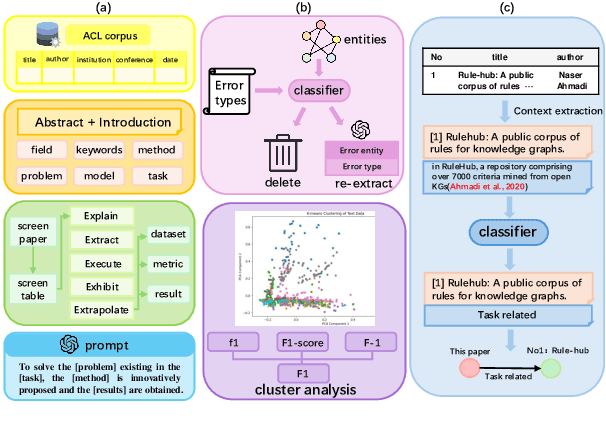
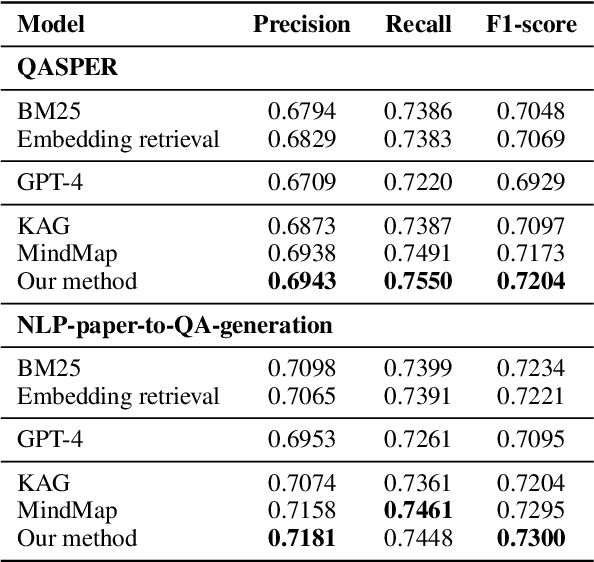
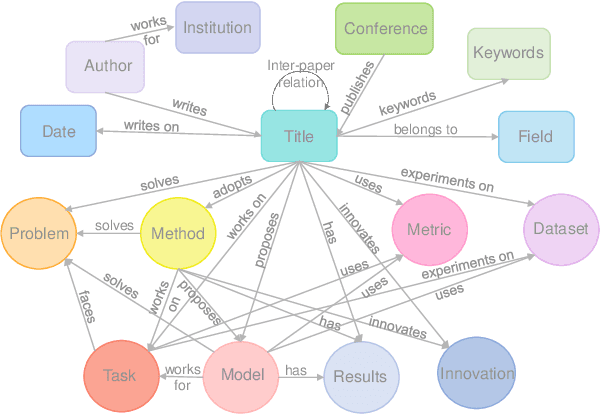
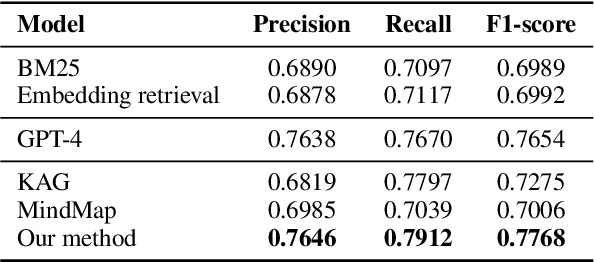
Abstract:Large language models (LLMs) have been widely applied in question answering over scientific research papers. To enhance the professionalism and accuracy of responses, many studies employ external knowledge augmentation. However, existing structures of external knowledge in scientific literature often focus solely on either paper entities or domain concepts, neglecting the intrinsic connections between papers through shared domain concepts. This results in less comprehensive and specific answers when addressing questions that combine papers and concepts. To address this, we propose a novel knowledge graph framework that captures deep conceptual relations between academic papers, constructing a relational network via intra-paper semantic elements and inter-paper citation relations. Using a few-shot knowledge graph construction method based on LLM, we develop NLP-AKG, an academic knowledge graph for the NLP domain, by extracting 620,353 entities and 2,271,584 relations from 60,826 papers in ACL Anthology. Based on this, we propose a 'sub-graph community summary' method and validate its effectiveness on three NLP scientific literature question answering datasets.
Ontology-Guided Reverse Thinking Makes Large Language Models Stronger on Knowledge Graph Question Answering
Feb 17, 2025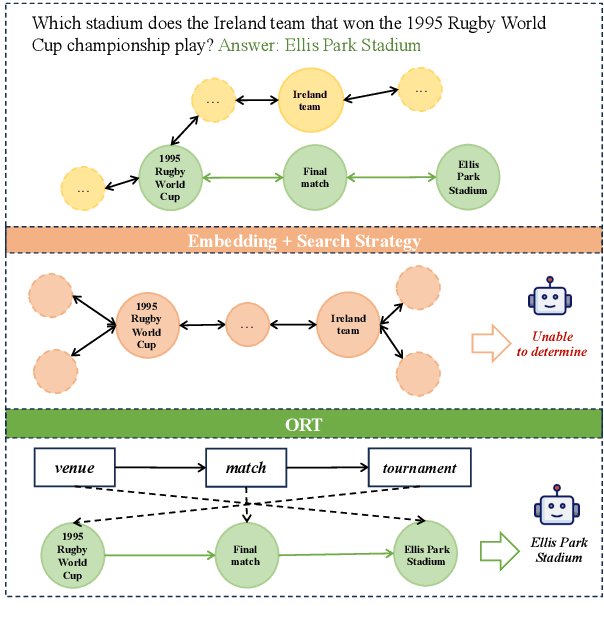

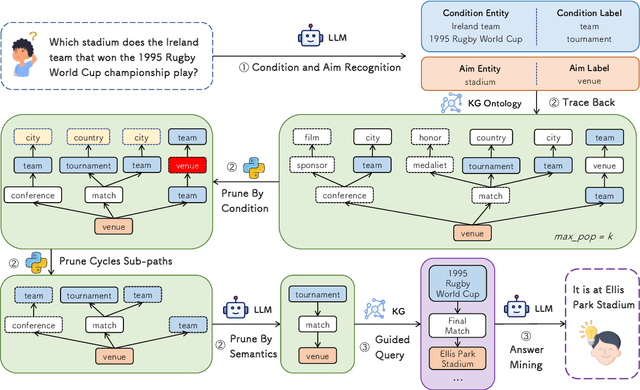

Abstract:Large language models (LLMs) have shown remarkable capabilities in natural language processing. However, in knowledge graph question answering tasks (KGQA), there remains the issue of answering questions that require multi-hop reasoning. Existing methods rely on entity vector matching, but the purpose of the question is abstract and difficult to match with specific entities. As a result, it is difficult to establish reasoning paths to the purpose, which leads to information loss and redundancy. To address this issue, inspired by human reverse thinking, we propose Ontology-Guided Reverse Thinking (ORT), a novel framework that constructs reasoning paths from purposes back to conditions. ORT operates in three key phases: (1) using LLM to extract purpose labels and condition labels, (2) constructing label reasoning paths based on the KG ontology, and (3) using the label reasoning paths to guide knowledge retrieval. Experiments on the WebQSP and CWQ datasets show that ORT achieves state-of-the-art performance and significantly enhances the capability of LLMs for KGQA.
StyleBlend: Enhancing Style-Specific Content Creation in Text-to-Image Diffusion Models
Feb 13, 2025Abstract:Synthesizing visually impressive images that seamlessly align both text prompts and specific artistic styles remains a significant challenge in Text-to-Image (T2I) diffusion models. This paper introduces StyleBlend, a method designed to learn and apply style representations from a limited set of reference images, enabling content synthesis of both text-aligned and stylistically coherent. Our approach uniquely decomposes style into two components, composition and texture, each learned through different strategies. We then leverage two synthesis branches, each focusing on a corresponding style component, to facilitate effective style blending through shared features without affecting content generation. StyleBlend addresses the common issues of text misalignment and weak style representation that previous methods have struggled with. Extensive qualitative and quantitative comparisons demonstrate the superiority of our approach.
 Add to Chrome
Add to Chrome Add to Firefox
Add to Firefox Add to Edge
Add to Edge